THE HISTORY OF THE GSSR
It was apparent to the authorities in the mid 1800s that it would be necessary to build railways (there were none in Almería at that time) to link Granada, Almería and Murcia. To this end, concessions were created to allow private companies to build and run these railways. These concessions were to be issued by means of a Royal Order (RO). On 12th August 1865, a Miguel Cremades received an RO without rights to make a study of whether it was possible to build a railway line between Lorca and Águilas Port or Garrucha. This he did but ten years later a Francisco de Laguardia received a concession to build the railway. Poor Miguel appealed the decision twice without success, which means that he disappears from the story.
On 27th March 1875 Lorca town hall agreed to support the project to the tune of 2 million pesetas by the use of debentures.
Francisco de Laguardia reported to the corporation that work had started on the railway on 27th March 1875 but there is little evidence of this. It seems that he was bogged down in bureaucracy and the fact that Águilas port was not considered sufficiently able to import or export goods. There followed much wrangling between a number of companies and town halls.
 In 1879 the government auctioned a concession to build a line between Granada and Murcia.
In 1879 the government auctioned a concession to build a line between Granada and Murcia. 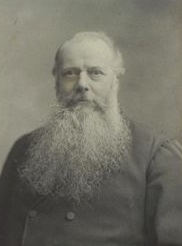 A British retired shipping merchant called Edmund Sykes Hett was the only bidder and so, on 15th December 1885 The GSSR was incorporated and building started.
A British retired shipping merchant called Edmund Sykes Hett was the only bidder and so, on 15th December 1885 The GSSR was incorporated and building started.
In October of 1885, the sum of £1,250,000 was raised (approximately £200 million today - not a lot compared to HS2 for example considering that the distances are almost the same - 299km), later to be increased to £1,684,357 for the construction of The GSSR. In addition, the Spanish government subsidy was only £532,000 (£70 million at today's rates, making the grant £150,000 per mile). See Finance. However, The GSSR wasn't the construction company, that being 'Hett, Maylor & Co Ltd' (Edmund Sykes Hett & John Maylor) who were to be paid a fixed sum of £2,089,184 (£270 million today) on completion of the project, and even they didn't seem to have done much work, the main construction being subcontracted to The Marquis of Loring (Jorge Enrique Loring y Oyarzabal) who had been successful in the past as a railway constructor, and August Lecoq, a metal construction expert.
The original Board of Directors comprised:
The Right Hon. Sir James Fergusson, Bart., M.P., G.C.H.L., K.C.M.G., 24 Grosvenor Gardens, S.W. (Chairman).Sir George Russell, Bart., M.P., Swallowfield Park, Reading. Director of the South-Eastern Railway company.
David Davies, Esq., M.P., Llandinam, Montgomeryshire. Deputy Chairman of the Barry dock and Railway Company.
Edward K Hett Esq., Eltham, Kent. Director of the Great Western of Brazil Railway Company (Limited).
W. Goodwin Barnes, Esq., Beaufort Lodge, Cambridge Park, Twickenham. Shipowner.
Perry F. Nursey, Esq., 161, Fleet Street, London, E.C. President of the Society of Engineers.
Alfred Fernandez Yarrow, Esq., Isle of Dogs, Poplar, London, E. Engineer.
Each of the above bought 100 £10 shares in the company, as did:
Howard Webb, Cardiff. Colliery prospector.Robert Mercer, Bromley, Kent. Civil engineer.
Nearly everything needed for the construction of the line was brought from Great Britain, France or Antwerp by ship.
Considering the difficult topography, construction went on at an impressive pace, the section between Almendricos and Águilas, having been started in October 1887, opened in April 1890. As an example of the topography from the point of view of a railway engineer, 133Km (41.8%) of the track between Granada and Lorca has inclines of 1 in 66 or steeper. The gauge was 1.668m (5ft 5¾in) as opposed to the British 1.435m (4ft 8½in).
The amount of work involved was enormous, there being more than three kilometres of construction by way of bridges, culverts, tunnels etc:
| Type | Length metres | Weight tons | Number |
|---|---|---|---|
| Bridges | |||
| Iron span | 40 | 96.1 | 2 |
| Iron span | 30 | 57.3 | 15 |
| Iron span | 20 | 24.7 | 13 |
| Iron span | 15 | 21.4 | 12 |
| Iron span | 12 | 29.3 | 2 |
| Iron span | 10 | 10.5 | 63 |
| Iron span | 8 | 7.9 | 4 |
| Iron span | 6 | 5.6 | 9 |
| Total | 1,710 | 2,431 | 120 |
| Iron span | 5 | 5 | |
| Iron span | 4 | 9 | |
| Iron span | 3 | 25 | |
| Iron span | 2 | 61 | |
| Iron span | 1.5 | 48 | |
| Iron span | 1 | 155 | |
| Iron span | 0.5 | 225 | |
| Total | 1,986 | 626 | |
| Masonry | 6 | 5 | |
| Masonry | 5 | 2 | |
| Masonry | 4 | 14 | |
| Masonry | 3 | 31 | |
| Masonry | 2 | 34 | |
| Masonry | 1.5 | 35 | |
| Masonry | 1 | 97 | |
| Masonry | 0.5 | 63 | |
| Masonry - twin arch | 8 | 1 | |
| Masonry - single arch | 10 | 2 | |
| Masonry - twin arch | 10 | 6 | |
| Masonry - triple arch | 10 | 1 | |
| Masonry - quadruple arch | 10 | 2 | |
| Masonry - over bridge | 18 | ||
| Total | 2,396 | 860 | |
| Other | |||
| Masonry - syphon | 1 | 16 | |
| Masonry - syphon | 0.6 | 67 | |
| Masonry - tube | 27 | ||
| Masonry - irrigation canal | 4 | ||
| Masonry - aqueduct triple arch | 1 | ||
| Masonry - tunnel | 613 total | 9 | |
| Level crossing house | 142 | ||
| Total | 3,097 | 1,038 |
There was an inauguration on 24th March 1890 whereby locomotive No 2 'LORCA' took all of the dignitaries to each of the stations on the branch line (Pilar de Jaravía, Pulpí and Almendricos - where this photograph was taken) during which Gustave Gillman took photographs (hover over a face).

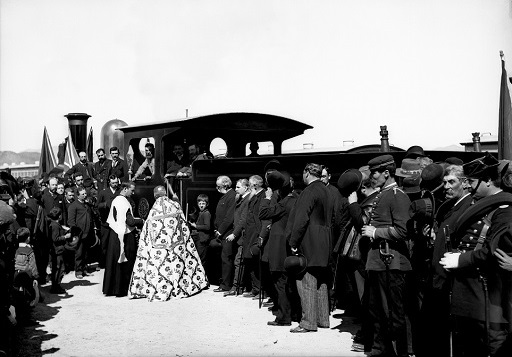 | 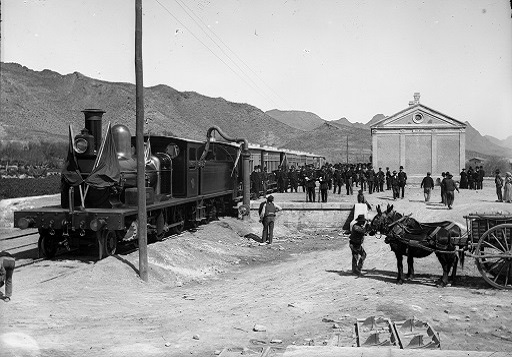 | 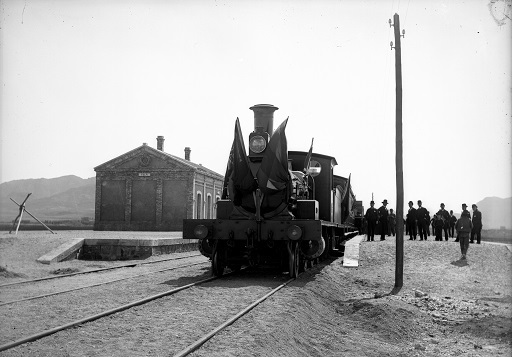 |
This included the difficult section Pulpí to Pilar de Jaravía part of which was the Puerto de los Peines.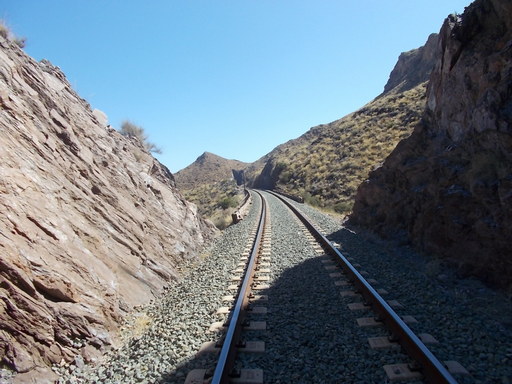 However, by the end of 1890, Hett, Maylor & Company were declared bankrupt. This was mainly due to the gross underestimation of the difficulties of constructing a railway in countryside such as that in Andalusia. In addition to this were the elevated costs of buying land, the lack of a road network making it difficult to transport heavy construction items and thus necessitating the construction of access roads before stations could be built, track laid or bridges constructed. Also, Hett, Maylor & Co were being ripped off by sub-contractors. On top of all of this was the bureaucracy that was endemic in Spain at the time (some would say that it still is). The Hett, Maylor & Co bankruptcy had dire consequences for The GSSR.
However, by the end of 1890, Hett, Maylor & Company were declared bankrupt. This was mainly due to the gross underestimation of the difficulties of constructing a railway in countryside such as that in Andalusia. In addition to this were the elevated costs of buying land, the lack of a road network making it difficult to transport heavy construction items and thus necessitating the construction of access roads before stations could be built, track laid or bridges constructed. Also, Hett, Maylor & Co were being ripped off by sub-contractors. On top of all of this was the bureaucracy that was endemic in Spain at the time (some would say that it still is). The Hett, Maylor & Co bankruptcy had dire consequences for The GSSR.
Notwithstanding, The GSSR pressed on with the construction of the rest of the railway. See below:
Here is a group photograph, probably taken around the same time as the one above. The people are as follows (clockwise from the top left):
Robert Charles Ogilvie
George Winfield Higgin.
Jorge Loring Oyarzabal.
Neil Kennedy.
Eduardo Argenti Schültz.
Samuel Agnew, an engineer.
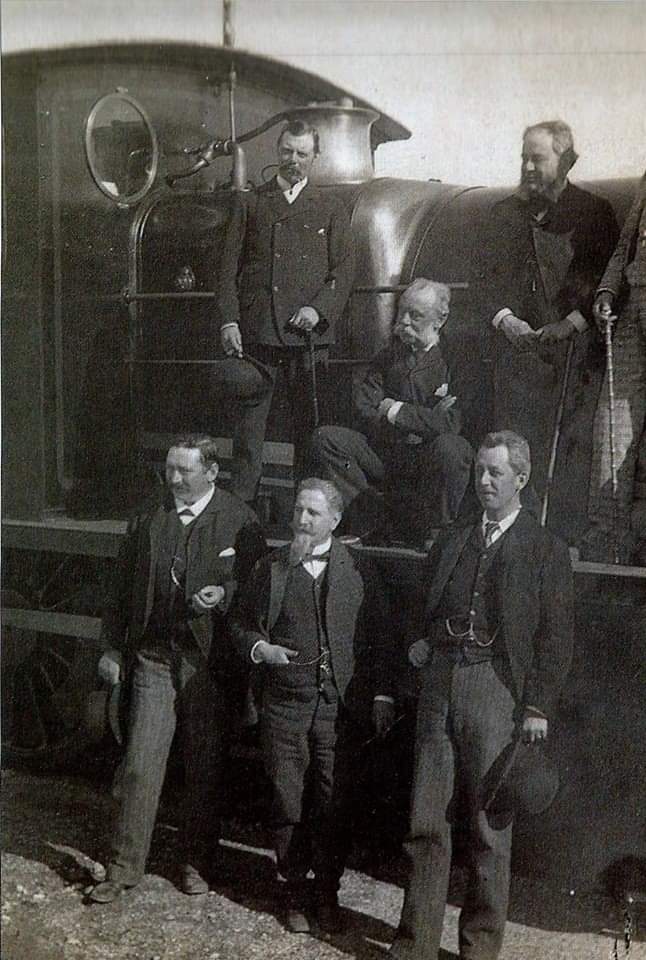
THE STATIONS
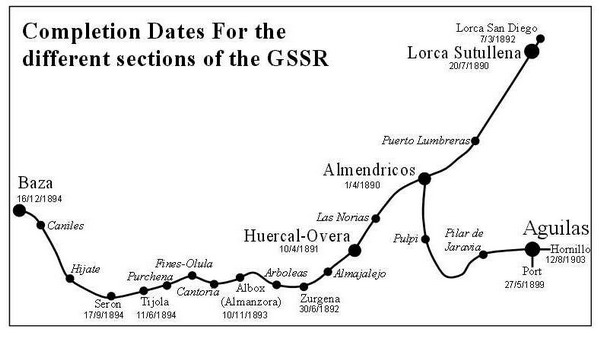
| Station | Date opened | Height above sea level (metres) | Distance from Lorca (km) | Date line closed | Station closed | Comments |
|---|---|---|---|---|---|---|
Lorca San Diego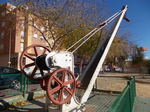 | 07/03/1892 | 327 | -1.350 | Open | Open | It was the terminus of the Alcantarilla - Lorca line. There were shunting yards and a turntable. Most of the original buildings have been demolished and replaced with new, but one can still see the original crane next to the station. |
Lorca Sutullena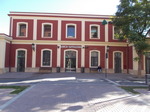 | 20/07/1890 | 328 | 0.171 (i.e. 170 yards from the official beginning of The GSSR) | Open | Open | The second largest station on the network, serving Lorca, a major town in the western part of the community/province of Murcia. |
Almendricos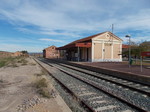 | 01/04/1890 | 333 | 23.702 | Open | Open | One of the first stations of The GSSR to be opened. Important hub between the Lorca - Baza and Baza - Águilas lines, requiring much shunting as there was no rail triangle so all of the goods/mineral trains from the Baza line had to reverse to be able to continue to Águilas and El Hornillo, and for this reason there was a turntable. Closed as a station on 7th November 1985 but still in use as a halt. |
Pulpí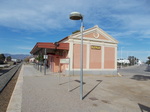 | 01/04/1890 | 132 | 33.690 9.988* | Open | Open | See Puerto de los Peines. Mineral trains were divided here as there wasn't enough power in one loco (300 or 400 tons force) to pull a complete train of 610 tonnes up to Puerto de los Peines, so the 12 wagons were divided and taken up half at a time. Other traffic was manufactured goods for retail, but not in huge quantities. Tomatoes were transported by the wagonload. Converted to sidings on 17th May 1970. It had a short reprieve late in 1977 when new track was laid as part of renovations between Almendricos and Águilas, and Pulpí was used as sidings for the track laying/maintenance rolling stock and as a junk yard for waste metal. |
Puerto de los Peines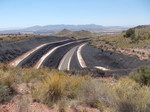 | 01/04/1890 | 213 | 38.008 14.309 | In use | 25/05/1970 | Important as the other end of the 1 in 83 incline from Pulpí. Divided goods trains were brought and parked. The loco would then reverse back to Pulpí to bring the other half of the train up the incline whereby it would be re-joined to the other half and then continue its journey to Águilas/El Hornillo. Each iron ore train weighed over 600 tonnes which was too much for a single loco to pull up a 1 in 80 incline. |
Cantera de Jaravía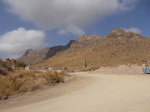 | 01/05/1970 | 213 | 41.783 18.081 | Open | Open | Created in 1983 as a loading point for ballast from a nearby quarry for laying the new track, as well as for Chinchilla - Cartagena, the stretch between Chinchilla and La Encina on the Madrid-Alicante line, the Totana - Lorca and all of the tracks between Lorca and Baza and the total branch line Almendricos-Águilas. |
Jaravía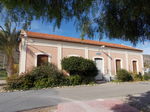 | 01/04/1890 | 140 | 42.450 18.748 | Open | Open | The first station on the Almendricos - Águilas line to close. In the days of steam it was important for shunting the locos from the rear of the goods trains from Cantera de Jaravia (which only had one line) to the front for the continuation to El Hornillo. |
Apeadero de Águilas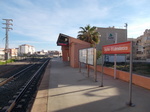 | 22/03/1984 | 6 | 48.168 29.420 | Open | Open | Also known as "El Labradorcico", it was opened as a halt on 22nd March 1984. It was constructed by a coalition between Águilas Town Hall and RENFE as a result of a long period of demands from the local people who lived nearby as a result of the expansion of Águilas. |
Águilas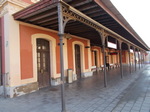 | 01/04/1890 | 6 | 54.344 30.642 | Open | Open | The largest and most architecturally impressive of all of the stations on The GSSR. Also the main site of engine sheds, maintenance workshops and administration offices. Important in Summer for foot passengers from the Almanzora Valley holidaying in Águilas. |
Águilas port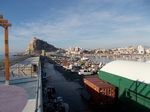 | 27/05/1899 | 0 | 55.352 | Closed late 50s | Track removed approx. 1970 | Always a thriving fishing port, goods were also exported. Originally, when The GSSR came to the port with iron ore, the material was moved by animals, but the arrival of the 35 ton wagons meant that a mechanical system became essential. The Águilas Port Co had a private line connecting it to The GSSR. There were seven turntables allowing access to the ore. A subsidiary of the port company, 'Mineral Loading Ltd.' installed a loading belt in 1908. This could handle 1,200 tonnes per day, using 800kg wagons. This port was where much of the materials for the construction of The GSSR were unloaded from ships. |
El Hornillo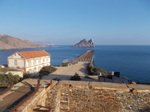 | 12/08/1903 | 0 | 55.342 | 31/12/1984 | 15/01/1974 | El Hornillo was essentially owned by The GSSR (see below). It was designed to accept regular deliveries of ore from The GSSR, to store it until a ship came in, and then to load the ship. There were two lines to allow this function. When there was no ship, the goods came via the line that went up a ramp which then levelled out alongside a hopper. The line divided into two, one each side of the hopper. The second line again divided into two, passing through tunnels under the hopper previously mentioned and straight out onto a 175m 14m high metal on concrete plinth pier. In this way, if a ship was in, the ore could be discharged directly from the wagons into the ship. When there were no trains to unload, the ore in the hopper was loaded into the wagons by gravity (see Los Canos) and shunted to the pier until the ship was full. Growth in traffic meant that a new hopper and two more tunnels had to be built giving El Hornillo a storage capacity of 50,000 tonnes. |
Puerto Lumbreras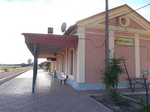 | 20/07/1890 | 333 | 10.760 | Open | Open | Serving the town of Puerto Lumbreras. Seven kilometres from the town itself but it would have had a trade in goods as it is placed in the centre of a fertile valley. Passenger numbers were very small for such a large town (eg in 1928 there averaged only 8 per day) possibly due to the large distance. |
Las Norias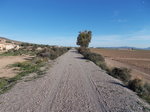 | 10/04/1891 | 360 | 30.614 | 31/12/1984 | 28/09/1985 | Always the least commercially viable station on the network. There were some mines nearby in the Sierra de Enmedio producing ochre as well as iron ore and other minerals, and the arrival of The GSSR stimulated mining in the area. Passengers averaged only 4 per day. Now, not one atom of it is left. |
Huércal Overa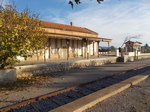 | 10/04/1891 | 305 | 41.774 | 31/12/1984 | 10/06/1981 | Although important for foot passengers and goods, it was also a key in the shunting of trains and locos. The track from Zurgena to Huércal Overa had an incline of 1 in 50 so the mineral trains from Serón and Los Canos had to be triple headers between Zurgena and Huércal Overa, two locos at the front and one at the rear. After this, the rear one was unhooked and returned to Zurgena, the train was divided for its onward journey to Almendricos. |
Almajalejo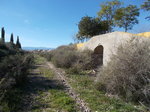 | 30/06/1892 | 305 | 46.000 | 31/12/1984 | Early 1968 | Nearly useless as a commercial enterprise, but essential in the days of steam as a braking point due to the incline between Zurgena and Huércal Overa. |
Zurgena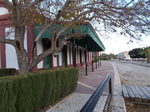 | 30/06/1892 | 264 | 52.707 | 31/12/1984 | 31/12/1984 | This station was very important from the point of view of the running of the railway. Apart from the station, there were engine sheds, workshops, supplies departments and offices. It was a storage point for goods trains to park overnight and to continue their journeys to Águilas / El Hornillo or Guadix in the early hours. Although it had no track machinery assigned to the station like Águilas and Lorca-San Diego, it was the site for the track machinery to be kept when not in use, but it did have permanent engineering staff. There was a turntable and the engine sheds had inspection pits for the locos. In addition, there were staff to manage sleep-overs for the train crews and their charges. Zurgena was an important station commercially, both in passenger traffic and goods. This wasn't due to the population of Zurgena, which was quite small, but that it also served the towns of Lubrín, Cuevas de Almanzora, Vera, Garrucha, Los Gallardos, Mojácar etc. There was important custom in entire wagons for the transport of marble and fuel and there were private lines into factories. |
Arboleas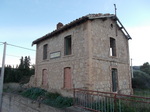 | 10/11/1893 | 298 | 57.875 | 31/12/1984 | 1964 | This station had an agent selling tickets for the express but the station was closed in 1964. |
Almanzora (Albox)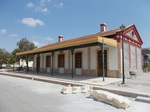 | 10/11/1893 | 337 | 63.235 | 31/12/1984 | 31/12/1984 | Nominally the station pertaining to the town of Albox but actually situated in Almanzora, in the borough of Cantoria. Mainly used for retail goods and livestock. Converted to a halt on 5th October 1981. |
Cantoria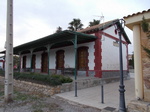 | 11/06/1894 | 362 | 68.370 | 01/12/1969 | 01/12/1969 | The main business was by commercial enterprises in Cantoria, Albanchez, Chercos, Cóbdar and Líjar. Much of the goods transport was marble and coffins as Cantoria had both of these industries. Converted to a halt on 1st December 1969. |
Fines-Olula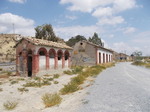 | 11/06/1894 | 457 | 77.840 | 31/12/1984 | 31/12/1984 | A busy station both in passenger traffic and materials from Olula del Río, Fines and Macael. The overwhelming amount of business was marble, crude, cut and worked. |
Purchena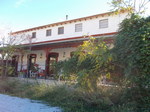 | 11/06/1894 | 523 | 83.524 | 31/12/1984 | 21/04/1975 | A little way from the town, this station was used mainly for the transport of marble and talcum, both of which were mined in the area. The station also served the towns of Somontín, Urrácal, Suflí and Sierro. |
Tíjola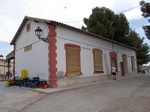 | 17/09/1894 | 665 | 93.736 | 31/12/1984 | 31/12/1984 | Tíjola was indispensible for The GSSR as it had a supply of good, relatively soft water only a kilometre away. The water was pumped to storage tanks at the station for the purpose of refilling the locos' tanks. Additionally, there was a pipe sending water to Zurgena Station with refilling points at Fines-Olula, Cantoria and Zurgena for the same purpose. Converted to a staffed halt on 1st January 1983. |
Los Canos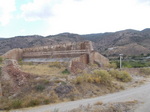 | 23/09/1912 | 760 | 98.300 | 31/12/1984 | 01/12/1969 | No passenger station, but was of enormous importance to The GSSR as the loading station for iron ore from Las Menas, San Miguel and Dulce María mines which came down on two cableways built in 1918. The buckets emptied into a 40,000 tonne stone hopper. Below the hopper were two tunnels that were designed to accept The GSSR iron ore wagons and to discharge the same through controlled shutters. There were three tracks, one of which was used for shunting of locos. To load the goods trains (each consisting of twelve XXT wagons carrying 35 tonnes of ore: 420 tonnes), the train shunted from the main line via a single set of points to one of the outer tracks. The loco was then unhitched and shunted back to push the wagons into the tunnel. It then travelled onto the main line whereby it went to Serón Station to be turned on the turntable (there was none at Los Canos), hence to return to Los Canos to re-connect to the wagons for the journey to El Hornillo. The train had to return to the centre track to pass over the weighbridge before continuing its journey. The weighing operation took place without the train stopping, simply travelling slowly to allow the technician to weigh each wagon. |
Seron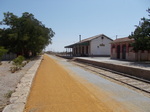 | 17/09/1894 | 769 | 101.857 | 31/12/1984 | 31/12/1984 | Serón was a very important station as it was the other transfer point for iron ore from the mines. There was a 20,000 tonne hopper for loading the goods trains. In addition it was a very important passenger hub as Serón was the main mining town and therefore the main transfer site for miners and workmen, goods, equipment etc. It had a turntable that was dismantled in 1976. It was converted to a staffed halt on 1st January 1983. |
Hijate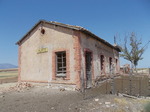 | 16/12/1894 | 974 | 114.006 | 31/12/1984 | Early 1980s | Unimportant commercially. The small town is 2km away. It had a small population and little industry to support the station. However, in the age of steam Hijate was very important as a hub, being the highest point on the whole of The GSSR. This meant that trains coming from Baza or Zurgena were triple headers, especially goods trains. Triple headers had two locos at the front and one at the rear. These trains were halted at Hijate for two of the locos to be uncouplead to return to their respective stations to start again. To explain why this was necessary it has to be understood that in the 61km between Zurgena and Hijate the track rises 710 metres, and between Caniles and Hijate 141 metres. These were important inclines in the days of steam. It must have been an impressive sight watching a triple header under full steam. |
Caniles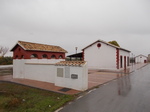 | 16/12/1894 | 833 | 128.116 | 31/12/1984 | Late 70s | Caniles was important in the day for the transport of sugar beet, refined sugar, molasses and other products of the sugar industry. At this point there wsa a private line into the factory itself (see Azucarera). After the sugar factory closed, the station went through some difficult times, closing in late 1974, opening again in Spring of 1976, finally closing in the late 1970s. |
Baza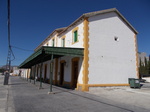 | 16/12/1894 | 872 | 133.000 | 31/12/1984 | 31/12/1984 | An important staion for The GSSR, seeing good passenger traffic as well as manufactured products. Also a hub for changing locos and minor repairs. There was a dormitory for rail workers and an extant turntable made by Cowans Sheldon Co., Carlisle. |
The Hett, Maylor & Co bankruptcy left The GSSR holding the baby to the extent that HM's creditors were causing serious problems for The GSSR, especially George Loring who had many connections in high places and put successful claims through the courts to seize all of the materials owned by The GSSR and to freeze their assets. This in spite of the debt being with HM, not The GSSR. He also arranged to place blockages on the Huércal-Overa to Zurgena section which was ready to open. See the article from 1917 in El Boletín, the newspaper of The GSSR.
RESTRUCTURING OF THE GSSR
The GSSR was in serious trouble, and wasn't even close to finishing the Baza to Granada section and they didn't have enough money to do this. They had, in fact, already built Deifontes and Piñar Stations and possibly much more. The answer was to restructure the company by first going into voluntary liquidation. Their main creditor (created in 1888 to build railways in Spain) was 'The Spanish Railways Trust and Investment Company' which re-arranged the concessions so that The GSSR only had the concessions for Lorca - Baza and Almendricos - Águilas/Hornillo. The section between Baza and Guadix was taken on by 'The Granada Railway Company Limited.' (TGR) which paid monies to The GSSR for services rendered. TGR also had almost insurmountable problems with construction which is why that section didn't open until 1907. It seems that The GSSR (Hett, Maylor) had brought in quite a lot of hardware for the Baza - Granada section which they proceeded to sell to The Granada Railway, and this probably helped the accounts somewhat. Originally a train journey from Granada to Murcia was to have been with the same company (The GSSR), but by 1907 the train passed over five!
| Granada - Guadix | South of Spain Railway. |
| Guadix - Baza | The Granada Railway. |
| Baza - Lorca | The GSSR. |
| Lorca - Alcantarilla | Alcantarilla - Lorca Railway. |
| Alcantarilla - Murcia | Madrid - Zaragoza - Alacant Railway. |
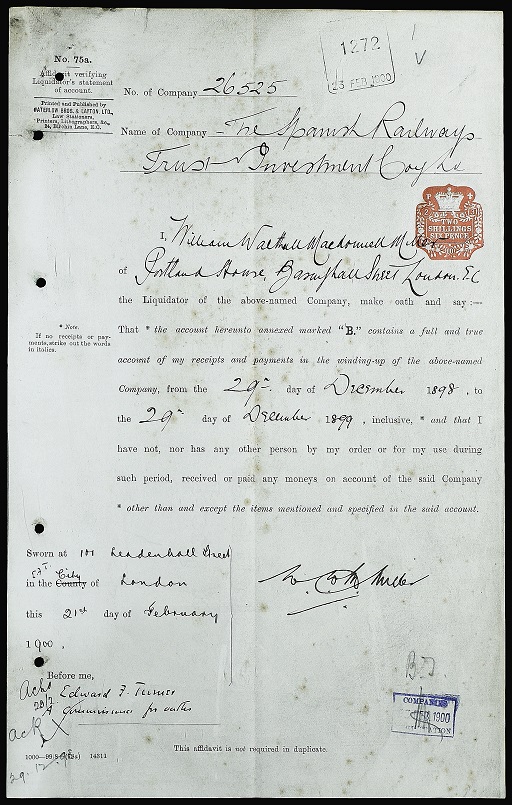 The GSSR had to go back to their investors for more money. As the track was already laid between Lorca - Baza and Almendricos - El Hornillo, they were only asking for a small amount to keep the company solvent until the fares rolled in! (they didn't).
The GSSR had to go back to their investors for more money. As the track was already laid between Lorca - Baza and Almendricos - El Hornillo, they were only asking for a small amount to keep the company solvent until the fares rolled in! (they didn't). 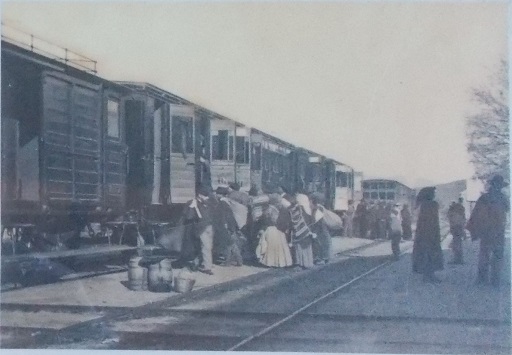 This was mainly because the section between Baza and Granada hadn't been finished, so there was little incentive for passengers to use The GSSR. However, now that there was a link to the north of Spain via Lorca / Murcia and to the port of Águilas there was a reasonable trade in merchandise such as esparto grass, marble, fruit, vegetables, wheat, barley, sugar beet and retail goods. In addition there was some passenger traffic although in 1897 it only warranted one passenger train each way per day.
This was mainly because the section between Baza and Granada hadn't been finished, so there was little incentive for passengers to use The GSSR. However, now that there was a link to the north of Spain via Lorca / Murcia and to the port of Águilas there was a reasonable trade in merchandise such as esparto grass, marble, fruit, vegetables, wheat, barley, sugar beet and retail goods. In addition there was some passenger traffic although in 1897 it only warranted one passenger train each way per day.
The journey from Lorca to Baza took 6 hours (1hr 30 minutes by car today) and a third class ticket cost an average worker nearly two days pay.
Anyway, the company had to go back to the investors and cancel all investments issuing new bonds, debentures etc referring only to Lorca - Baza/Águilas and not Murcia - Granada/Águilas. See the EGM. That must have been an interesting shareholders' meeting!
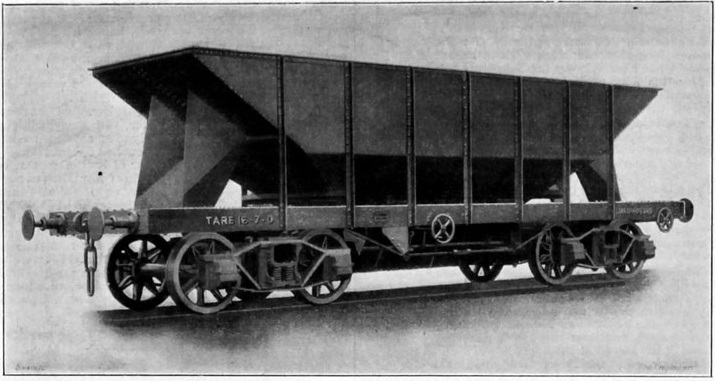 In fact, there was another restructuring of The GSSR in 1904 due to the need to purchase 150 40 tonne mineral wagons as a result of Gustave Gillman's amazing efforts to encourage mining along the route of The GSSR as well as more rolling stock so The GSSR restructured again. The fact that they were able to do this shows that the investors knew that without the mining transport their shares, debentures etc would be totally worthless. So, in 1904 the company managed to get its rolling stock and so a new era began for The GSSR (again!).
In fact, there was another restructuring of The GSSR in 1904 due to the need to purchase 150 40 tonne mineral wagons as a result of Gustave Gillman's amazing efforts to encourage mining along the route of The GSSR as well as more rolling stock so The GSSR restructured again. The fact that they were able to do this shows that the investors knew that without the mining transport their shares, debentures etc would be totally worthless. So, in 1904 the company managed to get its rolling stock and so a new era began for The GSSR (again!).
RAW MATERIALS
The two fundamental raw materials of a steam locomotive are coal and water, and both of these gave The GSSR enormous problems. Coal was expensive and had to be transported from northern Spain as for many years the Spanish Government demanded that Spanish railways used 95% Spanish coal, the quality of which was not as good as that from Wales. In addition, one of the biggest investors in The GSSR was one David Davies MP who was a Welsh colliery owner as well as the builder of Barry Docks and The Barry Dock Railway. It is fair to assume that he supplied the Welsh coal to The GSSR and had a fairly large influence on the company. Incidentally, he and Edmund Sykes Hett were co-directors of The Ocean Coal Co, so there were wheels within wheels. There was an incentive for foreign coal suppliers to bring their coal by ship to Águilas Port, whereby it could be transported by The GSSR to where it was needed. The First World War resulted in a fivefold increase in coal prices. The GSSR preferred British coal as it was of better quality and cheaper and could be brought in on the same ships that were transporting goods from Águilas Port. However, as stated above, the Spanish government issued a decree that coal for railway use would have to come from Spanish mines. This would be a perennial problem throughout the life of The GSSR.
Water also presented a serious problem, both lack and quality. The water available was so hard that the boilers were continuously having to be de-scaled and often there were as many as 8 boilers out of 25 on the Almendricos - Águilas route under repair, and Miguel Lloret Baldó said in El Boletín that it was unusual in the early days for a train to go from Águilas to Almendicos and return (61Km). After many problems, a melt-water spring was found near to Tíjola Station so a steam pump was installed and, on the 24th August 1911, soft water started running to the Tíjola tanks. A 3 inch (76mm) pipeline was installed from Tíjola to Zurgena (where there was a 300 cubic metre tank) for the same purpose, thus additionally supplying water to Purchena, Fines-Olula, Cantoria, and Almanzora. The problem became so bad (even resulting in a boiler explosion on the 14th September 1907 (there was another on 26th November 1918)) that, in 1907, The GSSR installed a Lassen and Hjort water purification plant in Águilas which turned out to be totally insufficient for the demands, only being able to supply two locomotives before the water became bad. After some years, on the 1st June 1911, The GSSR installed a seawater distillation plant which ran for many years, closing in 1922. The stations north of Tíjola had water delivered in a tanker by rail. This all begs the question as to whether The GSSR technicians looked into recycling steam back to the tender, especially seeing that there was a drought between 1912 and 1916. One thing is for sure, the water problem nearly destroyed a company that had survived the problems of building the line, near bankruptcy, droughts and many operational problems.
EL HORNILLO PIER
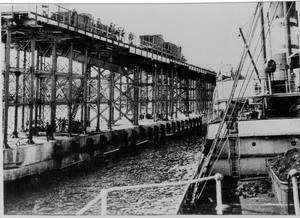 Edmund Sykes Hett obtained the concession to build the pier, and appears to have transferred it to The GSSR. On 12th July 1899 the Hornillo Company Ltd. was formed with £20,000 share capital and the pier opened on 18th August 1903. This pier functioned until closure of The GSSR (now RENFE) on 31st December 1984 during which time millions of tons of mineral were loaded onto freighters. The Hornillo Company Ltd. worked hand in glove with The GSSR. They shared the same office and most of the same company secretaries and The GSSR manager, Gustave Gillman
Edmund Sykes Hett obtained the concession to build the pier, and appears to have transferred it to The GSSR. On 12th July 1899 the Hornillo Company Ltd. was formed with £20,000 share capital and the pier opened on 18th August 1903. This pier functioned until closure of The GSSR (now RENFE) on 31st December 1984 during which time millions of tons of mineral were loaded onto freighters. The Hornillo Company Ltd. worked hand in glove with The GSSR. They shared the same office and most of the same company secretaries and The GSSR manager, Gustave Gillman
The pier was specifically designed to be able to unload ore from the wagons directly into the ships. Initially, there were two tracks for the unloading of ore, but the pier was later converted so as to have three tracks (one for returning wagons), and had a hopper capable of holding up to 25,000 tonnes of ore, later 50,000 tonnes.
INCOME
The income from passengers at the turn of the 20th Century was very poor as the section between Baza and Granada hadn't been completed, so there was little interest for passengers. Thus, for example, in 1902 there was only one passenger train in each direction per day. This was a mail train with first, second and third class passenger cars. It left Lorca San Diego at 13.24hrs and stopped at all stations. It passed Almendricos at 15.03hrs, arriving at Baza at 19.58hrs, averaging 20km/h (12mph). In 1908 the first train from Alicante to Granada passed through The GSSR and ran until it was suspended by RENFE in 1970 whereby they instigated an express between Barcelona, Granada and Almería.
The transport of goods was somewhat more promising although business started slowly. Most freight was marble (Fines-Olula), esparto grass, animals, minerals from mines near to Almendricos and Jaravía etc nearly all of which went to Águilas Port for loading onto ships.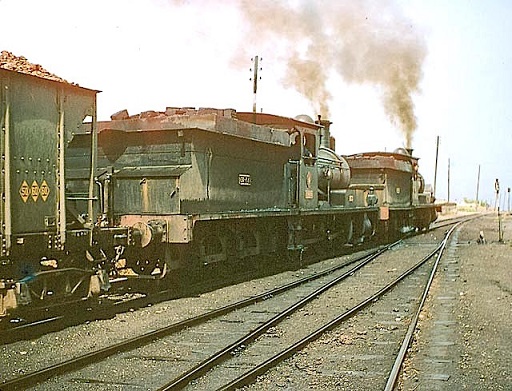 It has to be said that The GSSR was certainly saved by the opening of the mines in Las Menas, Bacares and El Tesorero and the pier El Hornillo in Águilas as well as government grants. However, matters improved in the early years of the twentieth century with a total of 124,396 tonnes of ore from the Sierra de Enmedio (Almendricos Station being in the foothills) as well as 403,272 tonnes from the Sierra de Los Filabres representing 1,257 trains of 12 wagons that year. The transport costs to the mining companies were significant, being approximately half of the costs of extraction and transport to the loaders. Due to the topography between Serón and Águilas there were stretches where double and triple headers were needed (two locos at the front, one rear).
It has to be said that The GSSR was certainly saved by the opening of the mines in Las Menas, Bacares and El Tesorero and the pier El Hornillo in Águilas as well as government grants. However, matters improved in the early years of the twentieth century with a total of 124,396 tonnes of ore from the Sierra de Enmedio (Almendricos Station being in the foothills) as well as 403,272 tonnes from the Sierra de Los Filabres representing 1,257 trains of 12 wagons that year. The transport costs to the mining companies were significant, being approximately half of the costs of extraction and transport to the loaders. Due to the topography between Serón and Águilas there were stretches where double and triple headers were needed (two locos at the front, one rear).
It is interesting to note that in 1915 (when there was a reduced market in iron ore due to the First World War) the chairman of the board, Mr. Thomas Harrison said, when talking about sales in 1914: "Minerals account for nearly £30,000, goods for £4,000, passengers £1,000".
There was a large variety of goods carried, including coffins, livestock, citrus, tomatoes, olives (and their oil), almonds, potatoes etc, wood, pine bark (for tanning), fertilizer, copper, calamine, sulphur, talcum, barium, gypsum, ochres, porphyry, lead, tin, silver and gold.
Agricultural products such as melons and tomatoes continued to be transported from Alicante to Águilas right up until the 1960s.
WARS
The First World War presented huge problems for The GSSR, in spite of the fact that Spain wasn't a combatant. Materials became very hard to get due to ships being sunk and coal became nearly five times as expensive. In addition, the company lost revenue from the lack of export of iron ore and other goods and the reduction of tourist passenger traffic. The GSSR wasn't the only company affected. Many of the smaller mines closed and there was real hunger amongst the Almerian population resulting in emigration to other countries. In 1915 fares (apart from First) were the same as they were in 1897 in spite of increased material costs. In spite of all of this, The GSSR soldiered on, surviving the war period, much impoverished.
In fact, the post war period of the 1920s was quite a good period for The GSSR, there being renewed demand for iron ore and other goods such as (esparto, marble, talcum) but before the motor car became a serious competitor. Nowadays marble and fruit and vegetables are carried by road on articulated lorries. The following table gives some indication of the relative weights carried (in thousands of tonnes). Numbers in blue are minimum for this period, those in red the maximum:
| Year | Iron Ore | Marble | Esparto | Cereals | Flour | Fruit & veg. | Other | TOTAL | Passengers x 1,000 |
|---|---|---|---|---|---|---|---|---|---|
| 1920 | 405 | 7 | 31 | 20 | 11 | 9 | 61 | 544 | 198 |
| 1921 | 150 | 9 | 12 | 13 | 12 | 13 | 64 | 273 | 196 |
| 1922 | 295 | 13 | 22 | 16 | 15 | 12 | 58 | 431 | 189 |
| 1923 | 385 | 11 | 31 | 13 | 17 | 13 | 66 | 536 | 170 |
| 1924 | 411 | 12 | 26 | 15 | 16 | 12 | 73 | 565 | 189 |
| 1925 | 413 | 12 | 19 | 12 | 14 | 12 | 96 | 578 | 202 |
| 1926 | 248 | 14 | 20 | 18 | 16 | 12 | 93 | 421 | 189 |
| 1927 | 659 | 15 | 18 | 11 | 16 | 11 | 88 | 818 | 169 |
| 1928 | 778 | 15 | 12 | 10 | 15 | 14 | 95 | 939 | 179 |
| Totals for period | 3,744 | 108 | 191 | 128 | 132 | 108 | 694 | 5,105 | 1,681 |
The maximum tonnages ever are as follows (x 1,000):
| Material | Tonnage | Year |
|---|---|---|
| Iron ore | 778 | 1928 |
| Marble | 18 | 1931 |
| Esparto | 31 | 1920 |
| Cereals | 33 | 1931 |
| Flour | 17 | 1923 |
| Fruit & vegetables | 16 | 1919 |
Comments: It is interesting that esparto represented approximately twice the weight carried than marble in spite of marble having a much higher mass. These data can be borne out by some of the old photographs from the turn of the twentieth century showing trains loaded twice the height of the sides of the wagons with esparto grass.
In the decade above The GSSR carried nearly four million tonnes of ore, representing by weight 73% of all goods carried.
The following table is an indication of the variety of goods that were transported by The GSSR in 1928 (one of the best years for The GSSR):
| Description | Tonnes | Amount £ rounded |
|---|---|---|
| Luggage | 98 | |
| H | ||
| FAST GOODS | ||
| Fish | 624 | 784 |
| Fruit | 1,137 | 1,014 |
| Livestock | 41 | |
| Provisions | 574 | 860 |
| Various | 4,322 | 5,425 |
| TOTAL | 6,657 | 8,123 |
| H | ||
| GOODS | ||
| Cattle and other livestock | 1,435 | |
| Building materials | 8,055 | 792 |
| Cement | 4,531 | 1,087 |
| Charcoal | 1,217 | 177 |
| Chemical products | 753 | 489 |
| Coal | 9,539 | 3,229 |
| Cotton and wool | 102 | 49 |
| Earths, industrial | 1,632 | 165 |
| Esparto | 11,930 | 3,543 |
| Flour | 15,415 | 6,700 |
| Forage | 3,370 | 1,145 |
| Fruit, except oranges | 5,033 | 2,041 |
| Furniture | 563 | 432 |
| Grain | 6,468 | 2,223 |
| Machinery | 2,492 | 938 |
| Manure and fertilizers | 6,124 | 2,218 |
| Marble | 15,220 | 4,635 |
| Metals | 15 | 4 |
| Molasses | 961 | 27 |
| Offal | 84 | 28 |
| Oil, mineral | 3,401 | 1,581 |
| Oil, vegetable | 2,598 | 1,690 |
| Oranges | 5,374 | 1,796 |
| Pine bark | 122 | 39 |
| Provisions | 2,939 | 1,650 |
| Rice | 1,265 | 568 |
| Salt | 1,439 | 535 |
| Spitituous liquor | 1,142 | 825 |
| Steatite | 1,072 | 304 |
| Sugar | 3,317 | 1,076 |
| Sugar beet | 9,036 | 1,236 |
| Sulphur | 127 | 45 |
| Textiles | 1,731 | 1,227 |
| Timber | 10,540 | 3,312 |
| Tobacco | 255 | 151 |
| Vegetables | 2,699 | 1,410 |
| Vegetables | 2,699 | 1,410 |
| Vegetable fibre | 490 | 139 |
| Wine | 3,194 | 924 |
| Various | 9,865 | 5,351 |
| TOTAL | 154,110 | 53,783 |
| H | ||
| MINERAL ORES | ||
| Iron | 778,432 | 157,874 |
| Lead | 83 | 25 |
| H | ||
| Sundry | 603 | |
| H | ||
| TOTALS | 939,282 | 221,940 (£13,700,000 today) |
The following table gives an indication of the relative traffic by station in 1928:
| STATION | PASSENGERS | GOODS | COMMENTS | ||
|---|---|---|---|---|---|
| Numbers | £ | Tons | £ | Baza to Lorca | |
| Baza | 19,317 | 2,520 | 21,498 | 8,583 | This was the beginning/end of the much slimmed down GSSR as the line linked up with 'The Granada Railway'. For a small remote town the figures look quite good, which is hard to explain. There are two rows for Baza, which seems to be an accounting activity. They are both one and the same. |
| Baza Junction | 7,486 | 1,712 | 25,358 | 13,030 | |
| Caniles | 5,329 | 251 | 5,563 | 1,334 | The big interest to The GSSR here was the sugar factory which continued in operation until the 1960s. |
| Hijate | 2,144 | 155 | 1,637 | 434 | Only grossing £36,336 pounds at today's rates, and remembering that this was a good year, it hardly paid for itself. Closed in the early 1980s. Most goods transported would have been esparto and agricultural products. |
| Serón | 7,166 | 695 | 203,580 | 31,293 | Serón was the hub between The GSSR and the Los Filabres mines. This explains the relatively large passenger numbers for a small country town, the passengers being miners and workers in the mining sector. |
| Los Canos | 567,874 | 80,449 | See Los Canos loader. The iron ore carried from Los Canos earnt the sum of a whisker under 5 million pounds (2019) in 1928. | ||
| Tíjola | 6,586 | 630 | 4,632 | 1,261 | Passenger numbers buoyed by the mines in Bayarque and Bacares. Most of the goods would have been iron ore from the mines coming down to the loader. |
| Purchena | 4,027 | 396 | 2,633 | 671 | Goods were mineral and talcum from the mines in Somontín and Urrácal. There would have been agricultural produce as well as esparto. |
| Fines-Olula | 6,383 | 588 | 11,130 | 3,473 | Nearly all of the eleven thousand tons of goods would have been marble from Macael, a huge marble quarrying area. A relatively healthy passenger figure was probably as a result of businessmen travelling within the marble industry. |
| Cantoria | 7,533 | 557 | 1,157 | 478 | Main goods custom was marble and coffins (a big industry in the day in Cantoria). |
| Almanzora | 9,014 | 893 | 4,544 | 1,749 | Goods were whole wagons of manufactured garments and livestock, as well as farm produce. |
| Arboleas | 1,607 | 121 | - | Another quiet station that didn't pay its way, grossing £7,464 (at today's rates) in that year. | |
| Zurgena | 7,068 | 726 | 7,902 | 2,628 | Healthy passenger numbers probably due to the fact that Zurgena served a large agriculturally productive area. Healthy goods figures included whole marble and fuel wagons. There would have been much agricultural produce as well. |
| Almajalejo | 855 | 54 | - | Well, a dead loss. Takings in 1928 £3,330 at today's rates representing just over two passengers per day! Survived as a station until 1968, surprisingly. | |
| Huércal Overa | 13,811 | 1,324 | 1,543 | 928 | It is hard to explain the large passenger numbers considering the town only has a population of 20,000. Not near the coast so no chance of tourism. Possibly residents travelling up the Almanzora Valley for work in the fields. |
| Las Norias | 1,637 | 95 | 4,140 | 540 | Few passengers as the station only served a small village. Goods would have been mainly minerals. |
| Almendricos | 6,963 | 342 | 9,533 | 1,053 | Most of goods would have been minerals from La Sierra de Enmedio. |
| Puerto Lumbreras | 2,669 | 125 | 1,514 | 242 | Small passenger numbers possibly due to the 7km distance of the station from the town. |
| Lorca Sutullena | 15,263 | 1,512 | 9,817 | 3,592 | Most goods were packets for individuals or small businesses. |
| Lorca Junction (San Diego) | 16,692 | 2,962 | 25,482 | 13,136 | Where The GSSR connected with the Alcantarilla-Lorca line. A lot of the passenger traffic would be through passengers from northern Spain. This is reflected in the average cost of tickets (£0.18) compared to Lorca Sutullena (£0.10). |
| Almendricos to Águilas | |||||
| Pulpí | 5,461 | 351 | 1,559 | 297 | Pulpí is located in the centre of a huge fertile basin which is given over to agriculture. Hence most of the goods carried were fruit and vegetables, especially tomatoes. There was also some industry in garments. The attraction of work probably swelled the passenger numbers. |
| Pilar de Jaravía | 2,561 | 73 | 6,004 | 2,289 | The fact that Pilar de Jaravía station is close to the mining area of Sierra de Aguilón, it is no surprise that there was a large amount of goods traffic as well as some passenger traffic in spite of the fact that Pilar de Jaravía is a tiny mountain town. |
| Águilas | 19,454 | 1,303 | 5,652 | 2,219 | Unsurprisingly, Águilas attracted a goodly number of passengers, those working on the port and El Hornillo as well as the holiday traffic from the Almanzora Valley, Barcelona and Madrid. |
| Águilas Port | 16,530 | 6,143 | Águilas Port had no passenger station. As a fishing port, presumably of the 16,500 tonnes carried were fish and seafood. | ||
| Kilometric tickets | 9,520 | 2,166 | These were long distance tickets that passengers could buy to save buying a new ticket every time they passed from one railway company to another. One can imagine (in the days without internet or computers) that the accounting became complicated! | ||
| Deposit & shipping | 46,154 | ||||
| TOTALS - Today's value £ | 178,546 | 19,523 - 1,204,500 | 939,282 | 221,940 - 13,692,000 | |
Comments: The sum of 15 million pounds a year seems an impressive amount except when one considers the costs of running a steam railway. The GSSR had over 900 staff at its height which only allows 16 thousand pounds a year (just above minimum wage in 2019) in wages if all other expenses (fuel, water, repairs, stock etc) are discounted. Relatively, wages were much lower in 1926 and The GSSR received government grants, but still it helps one to understand why none of the investors saw a return on their money.
RENFE (now Renfe)
The death of The GSSR came at the beginning of the Spanish Civil War when, on 17th July 1936 the Railway Worker's Council took control of the running of The GSSR, all its track and stock. This was part of the Republican side's activities and the Republicans ran the railway from this point. Eventually, The Nationalists under General Francisco Franco took control and set up a national railway network called RENFE which still functions today as Renfe.
The GSSR board of directors said this as part of their 1936 report to shareholders:
"The directors regret to report that on 5th September 1936, control of the railway was assumed by The Local Railway Worker's Council with the indulgence of the state representative. Subsequently, a decree of 26th December 1936 enacted that the state provisionally should take charge of the working of the remainder of the railways not comprehended in an earlier decree of 3rd August 1936, under the terms of which the workings of the large systems had already been taken over by The State and confided to the Railway's Exploitation Committee."
They didn't mention the fact that poor John Gillman, the son of Gustave, was arrested after only 20 days in the post of Managing Director, imprisoned pending execution. Fortuntely, he had friends in the government who arranged for his release and his escape to Gibraltar. When General Francisco Franco's forces won the war, he was allowed to return to Spain.
So, that was that, except that The GSSR lodged protests against the seizure of GSSR property, recruiting the British Chargé d'Affaires into the battle.
In fact RENFE was served a poisoned chalice as much of the rolling stock and track had been destroyed during the war, although The GSSR stock survived better than most of the Spanish railways as Almería and environs remained in Republican hands until the bitter end, thust preventing much destruction to rolling stock and track. The other problem for RENFE was lack of investment over many years such that the situation in 1963 was as follows:
| Period. | Km / miles track |
|---|---|
| Over 45 years old | 2,891 / 1,796 |
| 35 - 45 years old | 4,430 / 2,752 |
| 25 - 35 years old | 2,335 / 1,450 |
| 10 - 25 years old | 1,705 / 1,059 |
| Less that 5 years old | 2,063 / 1,282 |
| Total: | 13,424 / 8,341 |
Note: for comparison, the total length of track in Great Britian is 15,811 km (9,824 miles).
Additionally, during The Spanish Civil War 1,309 (42%) locomotives, 32,000 (40%) goods wagons and 3,700 (70%) passenger wagons were destroyed.
SLOW DEATH
The GSSR gamely carried on as a company based at 28, Austin Friars, London, England until, on 4th February 1955 the company was dissolved. In the intervening period between the end of The Spanish Civil War and the end of the company, the directors had been appealing regularly to the Spanish Government for compensation when, incredibly, in 1951, they received the sum of £114,434 (worth approximately £3,857,000 today). Of this, £104,163 was returned to holders of First Mortgage Debenture Stock. What happened to the remaining £10,271 (£276,000 today) is undocumented.
And what happened to the investors? The poor suckers who invested in The GSSR were to lose nearly all of their investments. In the restructuring of 1904, many of the investors lost the lot, save a few percentage points on their investment. Those who had preference shares would lose their preferential status and be re-issued at 10% of their value without preference. What that means is that if you had invested in The GSSR in 1885 the sum of £1,000 for example, with preferential shares, then in 1904, twenty years later (hoping for some returns) you would be told that your £1,000 was now worth £100 and that there were never any dividends. Worse, if you had taken out prior lien bonds they were converted to 5% of their original value, namely, £50.
It is fair to say that capitalism works in a similar way to Las Vegas, but it must have been hard for those who had invested in The GSSR to have lost nearly everything. No wonder that it was written in 'El Boletín' by Baldó:
"Those that had invested in the company came out very badly. The money lenders received debentures for their money and paper of dubious value for the interest. The debenture holders lost 50% of their capital with the remainder in shares that today (1918) are quoted on the stock exchange at 10% of their face value. The shareholders lost 90% and 95% respectively of their money. So, the first shareholders (if they had not already burnt their certificates in desperation) now owned 5 pesetas for every 1,000 pesetas invested. Probably they had sold them as scrap paper"
It would be easy to assume that the directors of The GSSR were fraudsters who relieved rich investors of their assets but this is highly unlikely. To walk The GSSR would show one that the work involved, without the aid of machinery, just pick and shovel, was incredibly arduous and required thousands of workers (2,400 actually). Most probably, the company was overwhelmed by problems created by the topography of the area. The only way to appreciate this is to walk the route and to wonder how they overcame the problems of the gorges, hills, rivers etc. It has to be said that without the brilliance of Gustave Gillman The GSSR would have become bankrupt. His heroic efforts to convince investors to invest in the mines of Los Filabres and to build a loader in Serón was pure genius. This man carried the whole of The GSSR on his shoulders for years, organizing the construction of El Hornillo pier to transport what became millions of tons of iron ore abroad.
At the end of the day the company was a British registered company and its accounts would have been rigorously inspected. Any irregularities would have been noted. If anything, the directors were guilty of stupidity and arrogance by thinking that they could come to Spain and build a railway. From what remains, one can see the incredible amount of investment that was made in this beautiful line.
The end came finally on 31st December 1984 when Renfe closed the line between Guadix and Lorca, ripping up track in the late 1990s. Thanks to the efforts of Águilas Town Hall, the line between Águilas and Lorca (and hence the rest of Spain) is still open with a limited service of two trains each way per day.
Some town halls have tried to maintain the station buildings; Serón, Cantoria, Almanzora and Tíjola being notable examples. Other buildings are in danger of falling down, especially Gor, Gorafe, Fines-Olula and Arboleas. Almanzora is currently (2019) being renovated again.
What is left of the track is mainly ballast although certain areas have been converted to green routes. Either way, they present excellent opportunities for walkers and mountain bikers to see the sublime Andalusian countryside first hand, and to appreciate the enormous amount of work that went in to constructing The GSSR.
Nearly all of what we know about The GSSR is thanks to a Don Miguel Lloret Baldó who wrote a regular column in El Boletín on the history of The GSSR. An English translation can be seen here.
GSSR R.I.P.

